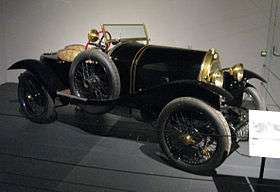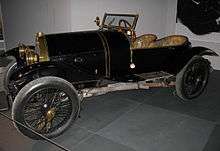Bugatti Type 18
The Bugatti Type 18, also called the Garros, is an automobile produced from 1912 through 1914. Produced shortly after the start of the business, the design was something of a relic. It had much in common with the cars Ettore Bugatti had designed for Deutz Gasmotoren Fabrik but with the radiator of the Type 13. Only 6 or 7 examples were built. Three are known to survive.[3]
| Bugatti Type 18 | |
|---|---|
 Black Bess | |
| Overview | |
| Manufacturer | Bugatti |
| Production | 1912-1914[1] |
| Powertrain | |
| Engine | 5,027 cc (307 cu in) Straight-4[2] |
| Transmission | four-speed sliding-pinion gearbox final drive by side chains[2] |
| Dimensions | |
| Wheelbase | 100.4 in (2,550.2 mm) Track 49.2 in (1,249.7 mm)[2] |
| Kerb weight | 2,750 lb (1,247 kg)[2] |
| Bugatti Engine type 18 | |
|---|---|
| Overview | |
| Manufacturer | Bugatti |
| Layout | |
| Configuration | vertical straight four-cylinder in front of the car[2] |
| Displacement | 5,027 cc (307 cu in)[2] |
| Cylinder bore | 100 mm (3.9 in)[2] |
| Piston stroke | 160 mm (6.3 in)[2] |
| Valvetrain | 2-inlet valves and 1-exhaust valve per cylinder mechanically operated by fingers between the overhead camshaft and the valves[2] |
| Combustion | |
| Fuel system | ignition by high tension magneto[2] |
| Output | |
| Power output | 100 bhp (75 kW; 100 PS) maximum r.p.m. 2,400[2] UK tax rating 24.8 h.p. |
Engine
Power came from a large 5.0 L (5027 cc/306 in³) straight-4 engine with 3 valves per cylinder and a single overhead camshaft. This large engine had a 100 mm bore and very long 160 mm stroke, so it could only rev to about 2400 rpm. The rear wheels were chain driven.[2]
Garros
Roland Garros (1888-1918) aviator, sportsman, close friend of Ettore Bugatti was the first owner of Black Bess in 1913. It was the fourth car built and was to be the only Bugatti with chain drive. A keen tennis player the French Open was named after Garros in 1927.
Black Bess
Named Black Bess, after Dick Turpin's mare, by 1920s owner, racing driver and garage owner Ivy Cummings. This car had a considerable career at Brooklands soon after the first World War. [3][4]
Road test
In spite of the advanced nature of its design the engine gives little of the harsh racing car impression. Again, in spite of the size of that engine it does not give the impression of a big car and in spite of the tall radiator the short wheelbase lends it the appearance of a small sports car. On the road that impression is reinforced, the delicacy of control makes it a joy to drive and one can still flick the gearlever about as you may do only in an early Bugatti.
The subdued howl and occasional suggestion of snatch from the side chains remind that this is a period car. If this car is typical of what the Prince Henry Tours produced the Prince Henry period can only be regarded as a most important constituent of the Golden Age.
Kent Karslake, 1956.[2]
Two other survivors
The only other surviving examples are in the Schlumpf Collection, Musée National de l'Automobile de Mulhouse, France and the other car is privately owned and in England.
Black Bess changed stable in 2009 for €2,427,500 and is now displayed in the Louwman Museum in the Netherlands.[4]
- Black Bess at Louwman Museum The Hague, coachwork is by Henri Labourdette

References
- Derrick, Martin; Clay, Simon (2013). Million Dollar Classics: The World's Most Expensive Cars. Chartwell Books. ISBN 978 0 7858 3051 1.
- Kent Karslake, Laurence Pomeroy, From Veteran to Vintage, Temple Press, London, 1956
- "Black Bess, famous Bugatti Type 18 goes under the hammer". New Atlas. 2009-01-30. Retrieved 2020-06-12.
- "Bugatti Type 18 Sports Two-Seater 'Black Bess'". Louwman Museum. 2013-08-04. Retrieved 2020-06-12.